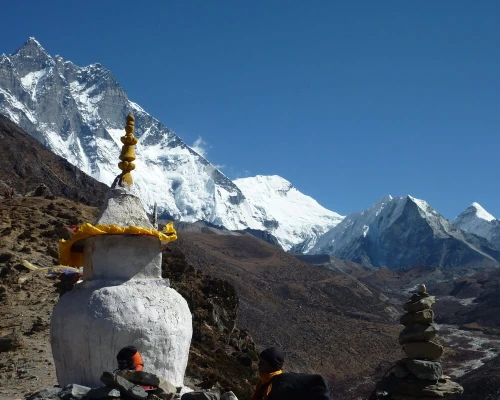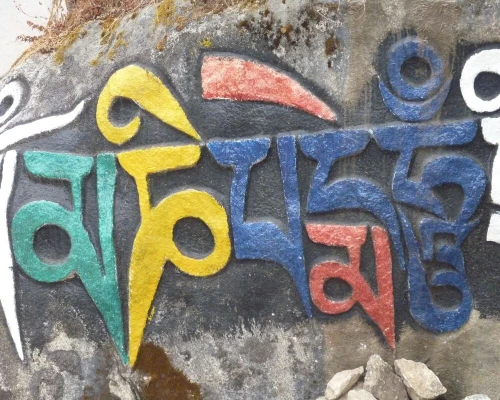Island Peak Everest Base Camp Trek 20 Days offer a remarkable combination of trekking and climbing in the Everest region. It is an ideal adventure for both novice climbers and mountain enthusiasts, providing a memorable peak climbing experience. The Island Peak, also known as Imja Tse, stands as a breathtaking island of rock and ice surrounded by glaciers and towering peaks measuring 8,000 and 7,000 meters. Island Peak, a renowned trekking peak in Nepal, requires crossing a glacier and participating in a para phase to reach its 6,189-meter summit.
- Embark on the iconic journey to Everest Base Camp, following the most treasured route.
- Along the way, you'll have the opportunity to explore Sagarmatha National Park, a UNESCO-listed heritage site known for its breathtaking natural beauty. Immerse yourself in the Sherpa culture as you visit Sherpa villages and gain insights into their unique lifestyle.
- Delve into the teachings of Tibetan Buddhism by visiting the renowned Tengboche Monastery.
- Marvel at the majestic Imja Valley, surrounded by awe-inspiring mountains like Lhotse, Ama Dablam, Makalu, and the mighty Everest itself, along with glaciers and mesmerizing ice falls.
- Finally, fulfill your mountaineering aspirations by conquering the summit of Island Peak. Prepare to be mesmerized by the stunning vistas and unforgettable experiences this remarkable region has to offer.
Island Peak Everest Base Camp and Kala Patthar
Embark on a high altitude hike to Everest Base Camp and Kala Patthar, allowing you to stand beneath the awe-inspiring summit of Mount Everest. En route, you will cross the challenging Kongma La mountain pass and eventually reach Island Peak Base Camp. Here, you will prepare yourself and don the necessary gear under the guidance of experienced climbers. Following your climbing guide, you will embark on the journey to conquer this beautiful peak. The trek will take you through Sherpa villages nestled on mountainsides, high mountain passes, and glaciers until you reach the Island Peak Base Camp, which serves as the starting point for your summit attempt. Sufficient acclimatization days are included in the itinerary to ensure your body adjusts well to the rarified air before you make your climb. Scaling Island Peak will likely be an extraordinary and unforgettable achievement, especially for those experiencing their first summit. The taste of this triumph is bound to stay with you for a lifetime.
Your safety is of paramount importance to us. Therefore, we take thorough measures to ensure the quality and reliability of our climbing equipment and gear used during the Island Peak Climbing expedition. Safety procedures are rigorously followed from the outset and throughout the journey. Your climbing guide possesses over 20 years of experience in mountain climbing, having successfully summited several peaks measuring 8,000 and 7,000 meters, including Mount Everest. They have also reached the top of Island Peak on multiple occasions. To enhance your chances of summiting, every two climbers will be supported by one assistant guide.
Pre Climb training at the Base Camp
Furthermore, our experienced guides provide valuable pre-climb training at the Base Camp. This serves as an excellent opportunity to refine your climbing skills and receive essential guidance. They will accompany you every step of the way, ensuring your safety and helping you achieve your goal. Additionally, we provide all the necessary climbing gear and equipment required to conquer Island Peak.
During the training, our climbing guide demonstrates the proper use of climbing gear and sets up fixed lines for practical climbing practice. We familiarize ourselves with various climbing devices such as ascending devices like Zummar, descending devices like Figure of Eight, safety ropes, ice axes, and crampons.
A crucial part of the training involves checking and adjusting our climbing boots with crampons and practicing walking with them. Depending on the specific conditions, our guide may also demonstrate ladder-crossing techniques as the climbing routes can vary.
Engaging in multiple rounds of practice instills greater confidence and courage, ensuring we are better prepared to challenge ourselves at high altitudes. The training equips us with the necessary skills and knowledge to tackle the upcoming climb with increased confidence.
6189m adventure begins early in the morning in the Himalayas
On the summit day of Island Peak, located at 6189 m in the Himalayas, the adventure begins early in the morning. We embark on an exhilarating scramble along a rocky ridge that leads us to a glacier. Beyond the rocky terrain, a steep snow headwall awaits, guiding us toward the summit. This physically demanding day presents a great opportunity for personal achievement.
To ensure a safe ascent, our experienced climbing guides permanently fix new ropes. Equipped with Jumar and harness, we tackle strenuous and challenging sections. The final climb involves ascending a 60-70 degree face, covering approximately 150 meters, until we reach the summit ridge.
From the pinnacle of Island Peak, an awe-inspiring panorama unfolds before us. Towards the north, a breathtaking semi-circle of colossal mountains reveals itself, including Nuptse, Lhotse, Lhotse Central, and Lhotse Shar. To the east, Makalu (8475 m) and Baruntse (7129 m) grace the horizon, while the iconic Ama Dablam (6812 m), a renowned expedition peak, stands proudly in the south.
In summary, the Island Peak Everest Base Camp Trek is a remarkable adventure that combines trekking and climbing in the Everest region. With proper acclimatization, experienced guides, and reliable equipment, you will have the opportunity to scale Island Peak and savor the taste of victory that will linger in your memories for a lifetime.



















